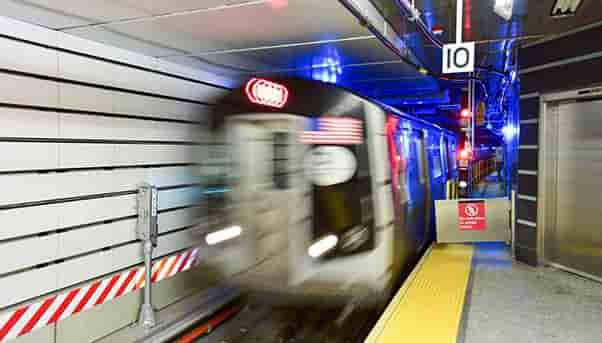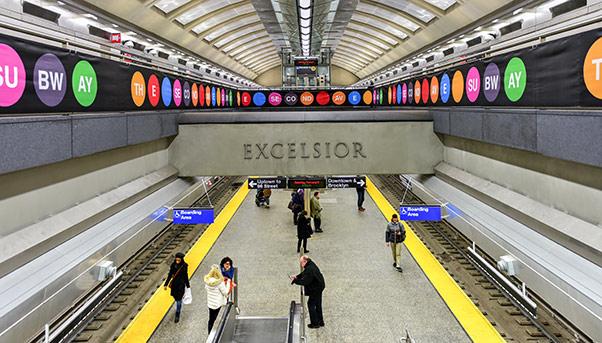
The screens in the subway trains running underneath the streets of Manhattan have been showing a promotional video by the Metropolitan Transportation Authority (MTA) inviting riders to discover an extension to the Q Line.
Not much promotion is needed, however, since the extension – known as the Second Avenue Subway that runs between 72nd Street and 96th Street under Second Avenue on the Upper East Side – leaves people breathless. The three new stations of steel and concrete along the line are examples of minimalism whose size makes an immediate first impression – an easy task especially on those who are used to the small stations in downtown Manhattan with the old columns, low ceilings and oppressive sense of claustrophobia. So arriving at one of the three stations at 86th Street is like entering a different world with its abundance of space and light.
The extension to the Q Line – the first phase of construction of the Second Avenue Subway – was inaugurated on New Year’s Eve, marking the first major expansion of the city’s subway system in half a century.
When including the buses and rail lines run by the MTA, the system is the largest in North America, serving 15.3 million people in an area that goes beyond Manhattan to include Long Island, southeastern New York State, and Connecticut, according to MTA’s website. Eliminating the need for the car helps avoid the emission of 17 million tonnes of CO2 every year. The subway and buses that serve the five boroughs of New York City carry 7.7 million people every day.
The Second Avenue Subway, which awaits three more phases of construction to reach its full extension, has quite a story behind it. Talk of building a subway to serve the east side of Manhattan dates back some 100 years. Since then, the only line to come into service has been the one underneath Lexington Avenue. No other line was built to serve this wealthy and densely populated part of the island. The reason is that the city’s plans for a second line kept being interrupted by one historic event or another.

The first project for the Second Avenue Subway came to being in 1919. But when construction was supposed to start a decade later, the stock market crashed, unleashing the Great Depression. A revised proposal came out in 1939, but it too was shelved with the advent of war. Decades would pass before another version of the project would reappear, only to have a fiscal crisis in 1975 put it on hold again. The idea for the Second Avenue Subway was revived one last time in 2004, with workers breaking ground three years later, according to a chronology of the line on the website of the MTA.
But the extension does not come close to resolving the problems faced by the subway system, problems that have accumulated over the years due to delays and lack of funding. As a result, service has suffered, with delays and longer interruptions becoming more frequent. With its 24 lines and more than 400 stations, the system is one of the most extensive in the world, an enormous underground city that is falling to pieces and in desperate need of a good cleaning and renovation.
Opened in 1904, the system is also one of the oldest in the world, alongside Paris and London. Although its trains have changed over the years – since becoming automated with air conditioning – the stations have yet to get their own facelift. Although this might have a vintage appeal for tourists, most commuters find it less attractive.
The state in which the system finds itself is emblematic of the poor condition of the country’s infrastructure. U.S. President Donald Trump has made it a priority to improve the country’s roads, bridges and railways with an investment of $1 trillion.
In the case of the Second Avenue Subway, it took 10 years and $4.4 billion to build less than four kilometres. There are plans to go ahead with the second phase, extending the line from 96th Street to 125th in Harlem. Scheduled completion: 2029. Cost: $6 billion. The line will then need two more extensions to complete its run to the top end of the island. The total cost of the project is estimated to be $17 billion. By comparison, the MTA has an annual budget of $11 billion – a small amount considering the hundreds more than it would need to upgrade the entire system. The biggest challenge is to get the funding. In early August, New York City Mayor Bill de Blasio proposed a tax on wealthy residents to help do that.
«Rather than sending the bill to working families and subway and bus riders already feeling the pressure of rising fares and bad service, we are asking the wealthiest in our city to chip in a little extra to help move our transit system into the 21st Century,» he said in a statement.
Although it is only a proposal, it confirms the city’s intention to invest more in the Big Apple’s infrastructure.

